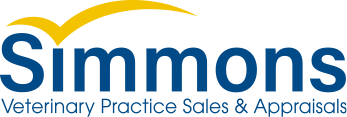David McCormick MS and Sherry Everhart BS, CVT –
Buying a practice is often a better alternative to starting a practice. An existing practice has a facility equipped with trained staff, and it serves an established client base. Most significantly, it has an existing level of profitability. These attributes can help a new owner avoid many of the risks associated with a practice start-up.
Assessing the For Sale Practice
When you encounter a practice purchase opportunity, the first step is to ensure that it matches what you seek. Are the practice philosophy and the standards of medicine in line with what you believe in and how you want to practice? Is it located in a community that you want to join? It is important to find the “right” practice, not just the “right now” practice.
Asking Price
Once you have found the right practice, you must start your due diligence and truly assess the purchase opportunity. The initial financial step is determining whether the asking price is reasonable enough to warrant further consideration. The buyer must answer the question, “Is this deal fair and affordable?”
You could have your own practice appraisal performed. While helpful, if the result is different from the seller’s price, the negotiations are based on differing opinions. You also do not learn much during the process other than the value conclusion.
Feasibility Analysis
Instead of a practice valuation, consider doing a purchase feasibility analysis. It is one of the most valuable tools for assessing a purchase opportunity.
Feasibility analyses, in general, are widely used to objectively assess the long-term impact of any significant expenditure such as investing in a piece of equipment (i.e., a new digital x-ray), a facility expansion, or other practice investments. It is the first step to take before any commitments are made or any significant resources such as your cash are invested. As a savvy future practice owner, a purchase feasibility analysis will likely be the first of many feasibility analyses that you will — or should — use as a practice owner.
Feasible Transactions
The purchase feasibility analysis is an objective test of the purchase scenario. Will the financial benefits of ownership outweigh the costs? If it is feasible, the transaction is likely fair, affordable and, assuming you have good credit, the veterinary lenders will provide the financing. In other words, you can proceed with the purchase.
Unfeasible Transactions
If it is not feasible, you may not be able to financially survive the purchase, and you may be unable to secure financing. Purchase price negotiation will be needed — and now they can be based on the realities of the practice’s financial data and other factual information instead of another appraiser’s opinion.
Historical Financial Data
The first step to the analysis involves assessing the practice’s historical financial data. The financial data is the foundation on which the cash flow projections are built. This typically includes the last three years’ financial statements, including profit/loss statements, tax returns, and the practice productivity reports, including revenues by category and the doctor’s production. The historical data reveals the practice’s profitability — the return on owning the practice. [As a side note, this information will also be needed by your lender when a decision is made to proceed with the purchase.]
Practice Profitability
Accurately assessing a practice’s profitability is integral to both a practice valuation and a purchase feasibility analysis. One of the biggest challenges to a buyer is trying to interpret the financial data on their own. This is because a business’s tax returns and financial statements seldom reflect true cash flow (i.e., profits). Instead, they are designed to minimize the earnings to reduce the practice’s tax burden. Thus the financial statements (usually a P&L or income/expense statement) typically need to be adjusted and restated before being meaningfully applied in a feasibility analysis. These are frequently referred to as adjusted or operational income statements.
To adjust the financial statements, additional information and details are needed. Below are some of the issues that often need to be addressed.
- Non-Operating Expenses – expenses included in the financials that will not pass to a buyer, such as the owner’s personal expenses.
- Non-Economic Expenses – expenses in the financials that are not actual flows of cash such as depreciation.
- Non-Recurring Expenses – one-time expenses such as replacing equipment, remodeling the reception area, or facility repairs.
- Other Expenses that may not be included in the financials but would become an expense of the buyer, such as the owner’s partner or spouse doing the bookkeeping without compensation, fair market rent, and the current owner’s veterinary compensation.
Cash Flow
After the adjusted or operational income statement is complete, the next step is to determine the cash flow or benefit stream(s) available to the new owner. There are potentially four such benefit streams to consider:
- The net operating earnings or profit from the practice ownership
- The owner’s veterinary compensation
- The owner’s management compensation when applicable
- The rent income collected from the practice if real estate is involved in the sale
The amount of owner compensation, both as a veterinarian and the owner-manager used in the feasibility analysis and in determining operational earnings, should be based on the level of medical services revenue. This is best determined using the practice’s productivity reports, such as revenue by doctor or sales by treatment reports. The purchase feasibility analysis may not provide a fair assessment of the purchase price if a reported industry ‘average’ for owner compensation is used instead.
The inclusion of rent income may or may not be applicable in the feasibility analysis depending on whether or not the buyer is purchasing the real estate. When the rent is included, the rent assigned should be related to the value of the real estate and the prevailing commercial lease rates in the area where the practice is located. In other words, the annual rent should cover the annual mortgage payments with a bit leftover.
Debt Service and Taxes
Once the benefit streams are identified, the debt service — principal and interest payments on the purchase loan — and the taxes can be taken into account. Using the asking terms of the seller and the potential financing terms of the lender, the debt repayments and annual tax liability should be projected over the entire term of the debt. These calculations can be complex, especially when the purchase includes both the practice and the real estate. It is helpful for one to be familiar with amortization and tax principles when making these projections.
Positive After-Tax Cash Flow
The difference between the benefit streams and the debt service and tax payments for each year (i.e., the after-debt, after-tax cash flow) represents the annual dollars available for the buyer’s household. If the after-debt, after-tax cash flow is a positive number, the purchase price is likely a fair market value, and you can proceed with the transaction.
Negative After-Tax Cash Flow
However, if the after-debt, after-tax cash flow is low or negative, the purchase price is too high. The buyer cannot afford to purchase the practice, and the veterinary lender is unlikely to loan them money. As noted, purchase price negotiations will be needed, and they can be based on the facts of the practice’s financial operation.
Personal Household Budget
Beyond assessing the purchase price, the after-debt, after-tax cash flow also should meet the buyer’s personal and household needs. All future owners should know their personal household budget needs and their personal financial requirements. While the test may show the price is a fair market value, if the feasibility analysis results are not enough to meet their personal debt and most basic needs, then the decision to move forward may not be wise.
Feasibility Analysis Considerations
As with any feasibility analysis, some assumptions are required — the rate at which revenues will grow, the level of profits expected as a percent of revenues, and tax rates, to name a few. While these may be educated guesses usually based on what the practice has experienced, there are obviously no guarantees. Therefore, when doing the feasibility analysis, it is beneficial to add variations that shift the key variables up and down. Adjusting the revenue growth, the practice profitability, and the financing terms can provide insight into positive and negative scenarios.
Typically, the most significant variable in a purchase feasibility analysis is the practice profitability. Minor changes to it can seriously change the after-debt, after-tax cash flows. Knowing the magnitude of these variable changes could have on personal income provides the buyer greater security in making a wise investment choice for their personal situation.
Simmons Is Your Veterinary Practice Sales & Appraisals Partner
While this article addresses a feasibility analysis from a practice purchase perspective, the concept and procedure are transferable to any purchase decision that needs to be made. For a practice purchase, while you can do some initial analysis, it may be worth engaging a qualified professional familiar with the veterinary profession and practice transactions to provide an independent assessment and review your work.
Purchasing a practice is a life-changing event. Finding the right practice at a fair price can help ensure your venture into business ownership is a rewarding one. Rely on the team at Simmons Veterinary Practice Sales and Appraisals for expert guidance, as well as assistance with buying, selling, and accurately appraising your practice. Contact us today.



